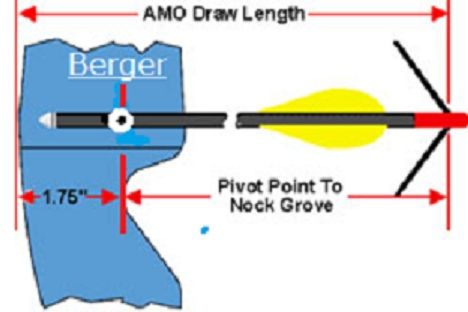
I see a few Questions on draw length or arrow length ...this may make it easier to understand...
DRAW LENGTH and ARROW LENGTH - A History**************************************
By Neil B. Stratton
What and where did “Standard” come from?-
In the early years of modern archery as it became more popular bow manufacturers had to come up with a “standard” for archery, so in the early 1950’s an organization for archery standards was formed.
It was called “Archery Manufacturers and Dealers Association” or AMADA with now famous members and icons such as Fred Bear.
In the 1960s it shortened its name to the “Archery Manufacturer and Merchant's Organization, or AMO as we knew it and its membership mostly consisting of archery manufacturers and AMO standards were greatly increased in the 1970s with the innovation of the compound bow.
The AMO is no longer in existence but there are 2 other organizations, the “International Bowhunters Association” or IBO which is where the standards for bows and archery we use mostly now…for example where you see IBO speeds…that speed was a standard measurement set by IBO.
We liked the IMO standards as it was great for compound shooters with faster speed ratings.
A newer organization, the “Archery Trade Association” or ATA will be an organization that we will see more of in the future for archery standards … both the IBO and ATA use most of the old AMO standards
DRAW LENTGH************
How and what is our true draw length and how is it measured?-
The AMO standard is"....draw length of a bow is determined by measuring the distance from the nock to the throat or deepest valley of the grip.
The nock measurement to be clear is from the inside throat of the nock or inside of string at nock point at full draw..
The valley of the bows grip is usually directly beneath the center of burger button hole or rest bolt hole in a straight line.
To determine draw length take that measurement then add 1 ¾ inch and you have your true standard draw length.
Why the 1 ¾ inch addition?...draw length was a standard set up by the AMO when most bows were recurve’s or long bows and had thicker risers- usually in that 1 ¾ inch range from valley of grip.
What is a Berger Button or Berger hole?
The Berger button is also known as a pressure button or plunger, invented by tournament shooter Norman Pint, but named after well known archer Victor Berger.
It was used on recurve’s for better arrow flight and accuracy, in the 1970’s we used them on even the 1st and 2nd generation compounds as the majority of us shot with fingers like Fred Bear.
The Berger on the riser now used as the insert for the rest bolt, is where we center rest and arrow, the Berger is like the center of the bow universe when manufacturing.
ARROW LENTGH**************
Arrow length for old school bow hunting was easy, as most rests were at Berger and the Rests then were to say the least, archaic and downright unsafe with the huge broadheads we hunted with.
As there was a good change the arrow could fall off the rest we didn’t want the broadhead anywhere near our hands, so most of us cut the arrows to the front of riser at least when drawn, some even cut arrows farther out from riser, past fingers out stretched forward for safety.
However now with rests being full containment and/or even backward of berger, but safe against arrow falling from rest onto hand or fingers when drawn, we can now cut arrows much shorter for a faster and more manageable length arrow.
Many now with rests centered on Berger or even back of berger towards string [once called an overdraw] will cut arrows with the center of riser when drawn; some speed demons will even cut close to containment rests for the extra speed.
IMHO I like to see arrows cut at the least around the 28” magic tuning mark, on most of standard draw length’s in the 27-28-29-30 inch draws for bow hunting, [Keeping arrow spine in mind for broadheads]
Of course longer and shorter draws dictate their lengths, short draws being a min of 24” for legal hunting length.
So in a sense your rest dictate’s your arrow length-
Your rest location can dictate arrow length as
The most forgiving setup is the rest contact point at the berger hole (which is 1 3/4" less than the bow's DL).
The arrows then cut 3/4 - 1" in front of rest contact, putting them approx. 1" less than your DL.
Most above applies to a bowhunting set up and some bows may vary.

Neil